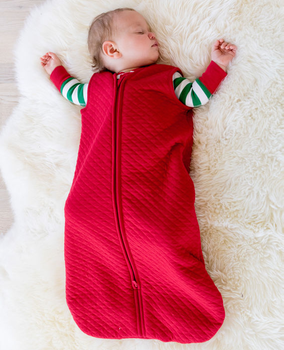Winter Series: Keeping Warm Inside
Baby, it’s cold inside too!
Whether you have an old, drafty house like me or you live in a cold climate, it may be time to stock up on some winter essentials for baby (or your tot). From cozy jammies and booties to sleep sacks and even humidifiers, we’ve rounded up our favorite winter gear for keeping baby warm at home.
But first, here are a couple of things you need to know, especially if you have an infant at home. Babies lose heat much faster than we do, but they also are prone to overheating. In other words, they aren’t the best at regulating their body temperature. To keep them as comfy and cozy as possible, the AAP recommends that you dress baby like you would, but add an extra layer.

Inside, aim for a comfortable room temperature around 68 to 72 degrees, and start peeling off layers as you see fit. If your baby is sweating or feels hot to the touch, it’s time to take the hat and sweater off.
A Note on Sleepwear and Flammability
The vast majority of severe burns occur to children while wearing pajamas around fireplaces, candles, furnaces, parents who smoke, etc. (although this is less frequent today than in the past). Consequently, the CPSC requires sleepwear intended for children between the ages of 9 months and 14 years to meet specific flammability requirements.

* Note that sleepwear for children under the age of 9 months is not subject to the requirement, mainly because these infants are not yet mobile.
Before you say, “My kid would never play with a candle (etc.),” remember: kids love fire and they also do stupid sh*t, especially when you’re not looking, so this requirement isn’t necessarily a terrible idea.
Essentially, sleepwear can pass the test in three ways:
1. The garment can be very snug-fitting (in case you always wondered why kids jammies are so tight). These usually have a yellow tag that says,
“For child’s safety, garment should fit snugly. This garment is not flame resistant. Loose-fitting garment is more likely to catch fire.”
Snug-fitting baby pajamas are not treated with flame resistant chemicals because they are less likely to be ignited and they burn far more slowly.
2. The garment can be “naturally flame resistant” if made with fabrics such as polyester (e.g. “fleece”) and other synthetics. Merino wool is naturally flame resistant, although usually pretty expensive. Merino wool is the gold standard in sleepwear if you can afford it (hint: buy used).
3. It can be treated with chemical flame retardant(s). You generally can’t tell what flame retardant is being used on any particular clothing item unless you ask. And no, you can’t really “wash it out” either (it would take a LOT of washing).
Many parents are not keen on chemical flame retardants on their kids’ clothes. I concur.
In real life, what this means is that jammies you see in stores are usually either snug-fitting OR made of polyester/fleece. If the jammies you are looking at are not one of these, they are likely treated with chemical flame retardant/s. Those pretty princess nighties from Disney and such? Yup. All treated.
Just something to keep in mind.
In this section, we will be going over the following 4 at-home winter essentials for baby and toddler:
Is part 3 coming? Is it about coats and mittens and boots (I hope)?
mittens is coming soon!!
Note that “naturally flame resistant” is generally code for fabrics in which the fibers were treated with flame retardants prior to making the garment. That is, the clothing company bought fibers that were already treated and so did not add the chemicals themselves. It does not mean there are no fire retardants in the clothing.
Marg — Would you say this is true for polyester but not for wool? It’s my understanding there’s no need to treat wool.
Great list, thanks for sharing!! We particularly love Baby deedee sleep nest. DD sleeps with one. No matter what I set the heater to, but she stayed warm and toasty. Such a great baby product. Loved there latest printed pattern, super cute .. https://www.babydeedee.com/products/41
I used a baby deedee sleep sack with DD from about 9 weeks old. Its so much easier, no worry about her getting the cover over her face whilst she is asleep. She doesn’t wake up cold as can’t kick it off.
Great list! loved baby deedee sleep sacks. Cool color options
How many sleep sacks do you need for your baby? Does it need to be washed after each night?
The Zipadee-Zip is by far the BEST wearable blanket for the swaddle transition journey one can buy for their baby. When my son started breaking out of his swaddle our entire sleep patterns began to be affected with my son not being able to sleep. The Zipadee-Zip worked wonderfully in soothing and comforting my child. It allows him to sleep for longer periods of time and he is usually sound asleep within 20 minutes of him being in it.
We currently have 3 sleep sacks. One for home, one for daycare, and a spare. We wash them once a week, unless there’s an accident which is why the spare is good to have. If daycare isn’t a concern, or you don’t use one for naps, you could get by with 2.
We have several sleep sacks (halo, deedee, fleece), but I struggle with what to dress my baby in for cold nights bc none of them have sleeves. I want to put her in fleece pjs, but then I worry that the rest of her will be too warm in the sack. Cotton footie pjs seem appropriate many nights, but then her arms are cold in the morning. Help!? Any thoughts?
I always used to put on a light sweater over the sleep sack on cold nights. Seemed to do the trick 🙂